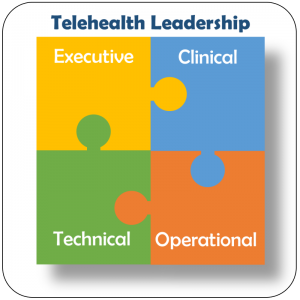This is a story about four leaders named Everybody, Somebody, Anybody and Nobody.
Once upon a time, during a big crisis, there was an important job to be done. Everybody was sure that Somebody would do it. Anybody could have done it, but Nobody did it.
Soon, Somebody got angry about that, because it was Everybody’s job. Well, Everybody thought Anybody could do it, but Nobody realized that Everybody wouldn’t do it.
It ended up that Everybody blamed Somebody when Nobody did what Anybody could have done.
While this is a funny story about the lack of responsibility and about passing the buck, it is also illustrative as to what is going on in many healthcare organizations regarding telehealth.
There are many people involved in telehealth these days, yet no one seems to be ultimately responsible for it. If the organization did not have any telehealth services before Covid-19, most organizations still do not have a designated “responsible adult”.
What does it take to lead telehealth?
I’ve said before that the launch of telehealth must be understood and organized as a launch of a new clinical service offering. You wouldn’t start a new clinical service line in your clinic or health system without assigning clinical and operational responsibility to someone, even if it’s just a part-time responsibility.
The same applies to telehealth, only that the breadth of responsibilities goes beyond clinical and operational duties. At a minimum (and it could be the same individuals) you additionally need to assign responsibility for telehealth-specific coding & billing; technology & technical support; marketing & publicity; compliance and licensing; etc.
The additional complexity with telemedicine during Covid-19 is that very few administrators have ever launched a completely new clinical service offering. There are numerous workflows to be defined — from scheduling to billing, from no-show handling to helping patients figure out the technology. There are clinical, operational, privacy, and technical policies to be written. Proper telehealth coding must be identified for each payor, with telephonic and live audio/video modalities increasing the complexity of billing.
The launch of a new clinical service, especially during a crisis, requires attention to key organizational change management principles, including proper and adequate training as well as ongoing support and supportive leadership (i.e., praise for a job well done!).
Few administrative leaders are equipped with the experience to lead the staff and the clinicians effectively through such a tremendous amount of change, let alone the skill set required to design a complete new set of workflows vs. the incremental improvements on existing processes.
So who should be in charge?
Within a typical healthcare organization of any size, there are a number of obvious and non-obvious choices.
As is often the case in healthcare, especially in times of crisis, many people simply step up to the task and get done what needs to get done. Yet that also means that there is virtually no one in charge, that the quality of the work is not being checked and there is little to no accountability.
While that was fine for the first weeks of the crisis, 3 months into it, each organization should have by now identified an official telehealth leader to bring order, structure, and accountability to this new service line.
In a best-of-class model 


-
Executive Leadership
-
Clinical Leadership
-
Technical Leadership
-
Operational Leadership
Anybody can now expect Somebody to do it








To receive articles like these in your Inbox every week, you can subscribe to Christian’s Telehealth Tuesday Newsletter.
Christian Milaster and his team optimize Telehealth Services for health systems and physician practices. Christian is the Founder and President of Ingenium Digital Health Advisors where he and his expert consortium partner with healthcare leaders to enable the delivery of extraordinary care.
Contact Christian by phone or text at 657-464-3648, via email, or video chat.







Leave A Comment